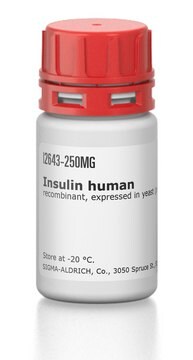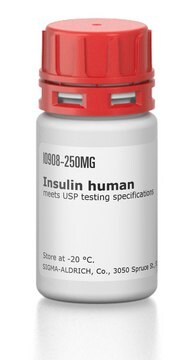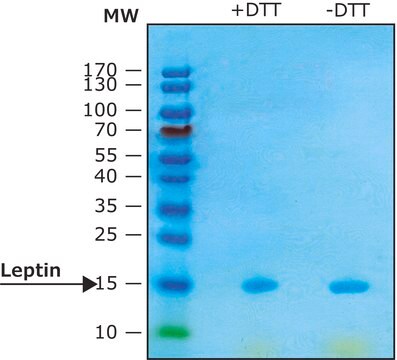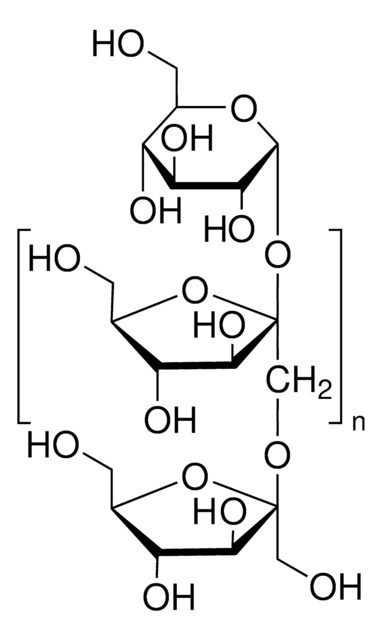I3661
Insulin-FITC labeled human
recombinant, expressed in yeast, lyophilized powder
Synonyme(s) :
FITC Insulin, Labeled Human Insulin
Se connecterpour consulter vos tarifs contractuels et ceux de votre entreprise/organisme
About This Item
Produits recommandés
Produit recombinant
expressed in yeast
Niveau de qualité
Forme
lyophilized powder
solid
Composition
Insulin, ≥75% biuret
Ampleur du marquage
≥1 mol FITC per mol insulin
Conditions d'expédition
dry ice
dry ice
Température de stockage
−20°C
−20°C
Description générale
Insulin is a polypeptide hormone mainly secreted from pancreas when glucose level changes in the plasma. It is an anabolic hormone and enhances the generation of storage substances, for instance glycogen, fat and protein. It also induces glucose uptake by peripheral tissues, thereby controlling glucose levels in the plasma. Its main sites of action are liver, adipose tissue and muscle.
Application
Insulin-FITC labeled human has been used in primary endothelial cells from human adipose tissue microvasculature (HAMEC) to study insulin transcytosis.
Forme physique
Lyophilized powder containing sodium phosphate buffer salts
Code de la classe de stockage
11 - Combustible Solids
Classe de danger pour l'eau (WGK)
nwg
Point d'éclair (°F)
Not applicable
Point d'éclair (°C)
Not applicable
Faites votre choix parmi les versions les plus récentes :
Déjà en possession de ce produit ?
Retrouvez la documentation relative aux produits que vous avez récemment achetés dans la Bibliothèque de documents.
Les clients ont également consulté
Cristina C Clement et al.
Scientific reports, 8(1), 11253-11253 (2018-07-28)
Transport of tissue-derived lymphatic fluid and clearance by draining lymph nodes are pivotal for maintenance of fluid homeostasis in the body and for immune-surveillance of the self- and non-self-proteomes. Yet a quantitative analysis of nodal filtration of the tissue-derived proteome
Espinal J
Understanding Insulin Action: Principles and Molecular Mechanisms (1989)
Aaron L Glieberman et al.
Lab on a chip, 19(18), 2993-3010 (2019-08-30)
Pancreatic β cell function is compromised in diabetes and is typically assessed by measuring insulin secretion during glucose stimulation. Traditionally, measurement of glucose-stimulated insulin secretion involves manual liquid handling, heterogeneous stimulus delivery, and enzyme-linked immunosorbent assays that require large numbers
Hanwoong Woo et al.
Molecular brain, 11(1), 37-37 (2018-07-05)
Chronic stress is a psychologically significant factor that impairs learning and memory in the hippocampus. Insulin signaling is important for the development and cognitive function of the hippocampus. However, the relation between chronic stress and insulin signaling at the molecular
Nicolas J Pillon et al.
American journal of physiology. Endocrinology and metabolism, 309(1), E35-E44 (2015-05-07)
Obesity is associated with inflammation and immune cell recruitment to adipose tissue, muscle and intima of atherosclerotic blood vessels. Obesity and hyperlipidemia are also associated with tissue insulin resistance and can compromise insulin delivery to muscle. The muscle/fat microvascular endothelium
Notre équipe de scientifiques dispose d'une expérience dans tous les secteurs de la recherche, notamment en sciences de la vie, science des matériaux, synthèse chimique, chromatographie, analyse et dans de nombreux autres domaines..
Contacter notre Service technique









